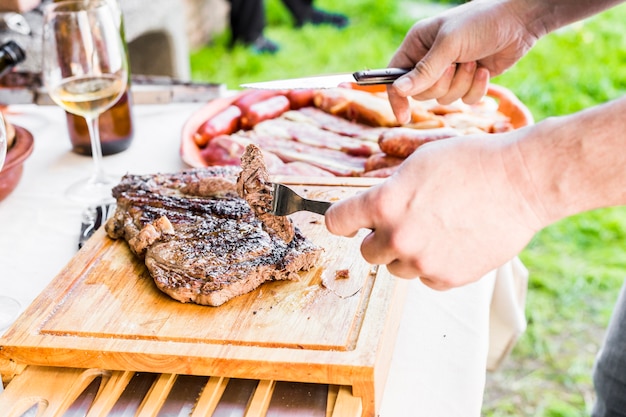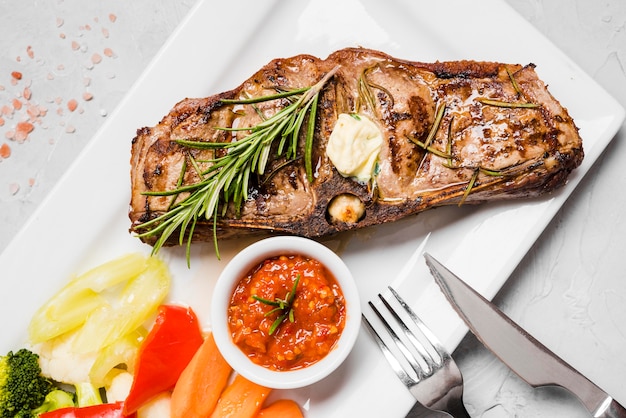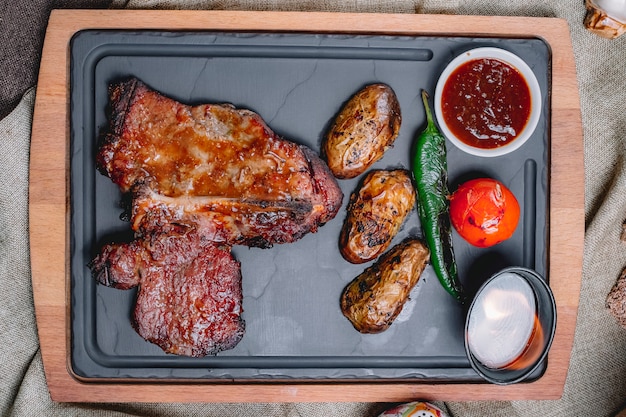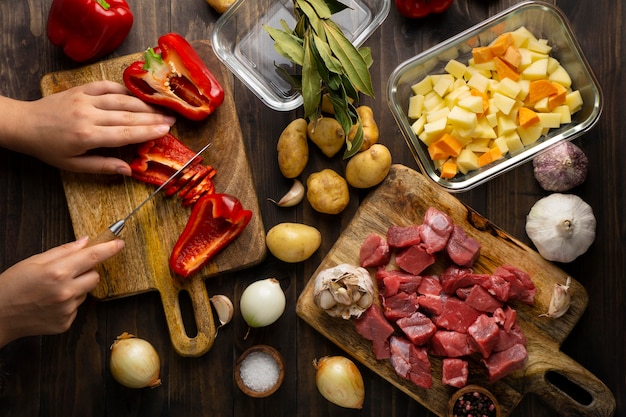(Part 1) Choosing Your Rib Roast: The Star of the Show

The Prime Cut: It's All About Flavor
You want a prime rib roast, hands down. It's the most tender and flavorful cut you can get. And when I say "prime," I mean it. Look for a roast that's well-marbled. Those streaks of fat are like flavor bombs waiting to explode! They render during cooking, giving your roast a rich, almost buttery flavour and keeping it incredibly moist.The Right Size: Don't Be Afraid to Ask
For a 4-pound roast, you're looking at something that's perfect for a family gathering or a more intimate dinner. Don't be afraid to ask your butcher for their advice. They're experts, and they're usually thrilled to help you find the perfect cut.(Part 2) Prepping Your Roast: Getting Ready for the Oven

Salt is King: A Dry Brine Makes All the Difference
Here's my secret weapon: dry-brining. It's the best way to enhance the flavour of your roast. You simply generously salt the roast and let it sit uncovered in the fridge for 12-24 hours. The salt draws out moisture and then draws it back in, concentrating the flavour and creating a more tender roast. Seriously, it's a game-changer.Removing the Membrane: Unlocking Flavor
There's a thin, tough layer of tissue called the membrane on top of the roast. It needs to go! It's like a barrier, preventing the roast from browning properly and absorbing flavour. Use a sharp knife to carefully loosen the membrane and peel it off.Seasoning: The Final Touches
Now for the fun part - seasoning! Salt and pepper are the classic combo, but don't be afraid to add some extra flair. Garlic powder, onion powder, herbs, even a bit of paprika – the possibilities are endless! Be generous with the seasonings – they'll infuse the roast with flavor as it cooks.(Part 3) Cooking Time: The Magic of Temperature

Target Temperatures: Unlocking Your perfect roast
Here's the key to a perfect roast: knowing your desired internal temperature. For a 4-pound roast: Medium-rare: 135°F (57°C) – The perfect balance of pink and tenderness. Medium: 140°F (60°C) – A touch more cooked, still juicy and flavorful. Medium-well: 145°F (63°C) – A more well-done roast, for those who prefer it that way.Estimating Cooking Time: A Rough Guideline
A 4-pound roast typically takes about 2-2.5 hours in a 325°F (160°C) oven. But remember, every oven is different. Don't rely solely on this estimate – use a meat thermometer to make sure your roast is cooked to perfection.Resting Time: The Key to Tenderness
Once the roast is done, don't cut into it right away! Let it rest for at least 15 minutes before carving. This allows the juices to redistribute throughout the meat, resulting in a more tender and flavorful roast.(Part 4) Cooking Methods: Roasting in the Oven - The Classic Approach
The Classic Method: Simple and Effective
An oven is the classic way to roast a rib roast. It's simple, reliable, and delivers excellent results. Preheat your oven to 325°F (160°C). Place the roast on a roasting rack in a shallow roasting pan. The rack allows hot air to circulate around the roast, ensuring even cooking.Basting: Adding Moisture and Flavor
Basting is optional, but it's a good way to keep your roast moist and develop a beautiful crust. Use a mixture of beef broth and red wine, or even just plain water, to baste the roast every 30 minutes or so.Checking for Doneness: The Meat Thermometer is Your Best Friend
Use a meat thermometer to check the internal temperature of the roast. Insert the thermometer into the thickest part of the roast, avoiding any bone. Once it reaches your desired temperature, it's time to let it rest.(Part 5) Cooking Methods: Roasting in a dutch oven - Control and Evenness
The Dutch Oven Advantage: Trapping Heat and Flavor
A Dutch oven is my go-to for a perfectly cooked roast. It's like a little oven within an oven! Its thick walls and tight-fitting lid help to trap moisture and create a more even cooking environment.Heat Distribution: Achieving That Perfect Crust
Preheat your Dutch oven over medium-high heat. Once it's hot, add a tablespoon or two of oil to the pot and sear the roast on all sides until it develops a nice crust. Then, transfer the roast to a roasting rack inside the Dutch oven and add a cup of beef broth or water to the bottom of the pot.Covered or Uncovered: The Best of Both Worlds
Keep the Dutch oven covered for the first hour of cooking. This helps create a steamy environment, ensuring the roast stays moist. After that, you can remove the lid to allow the roast to brown and develop a crispy crust.(Part 6) Cooking Methods: reverse searing - Slow and Steady Wins the Race
Slow and Steady: Unlocking Tenderness
Reverse searing is a game-changer for achieving a perfectly tender roast. You cook the roast at a low temperature for an extended period, followed by a quick sear at a high temperature. This results in a roast that's incredibly tender and evenly cooked.Low and Slow: Patience is Key
Preheat your oven to 250°F (121°C). Place the roast on a roasting rack in a shallow roasting pan and cook for 2-3 hours, or until the internal temperature reaches 120°F (49°C).The Final Touch: Achieving that Delicious Crust
Once the roast has reached 120°F (49°C), increase the oven temperature to 450°F (232°C). Remove the roast from the oven, pat it dry, and sear it on all sides for 5-10 minutes until it develops a nice crust. This final sear gives the roast a beautiful color and a delicious crispy exterior.(Part 7) side dishes that Shine: Complementary Flavors
Roasted Vegetables: The Perfect Pairing
Roasted vegetables are a classic accompaniment to a rib roast. I love to roast root vegetables like carrots, potatoes, and parsnips with a bit of olive oil, salt, pepper, and herbs. They're delicious roasted alongside the roast in the same oven, absorbing the delicious aromas and flavors.Creamy Gratins: Rich and Decadent
A creamy potato gratin or a cheesy cauliflower gratin is a rich and decadent side that adds a touch of elegance to the meal. It balances out the richness of the roast, creating a truly satisfying combination.green beans: Fresh and Vibrant
A simple green bean side dish provides a fresh and vibrant contrast to the richness of the roast. You can steam them, sauté them, or roast them with garlic and herbs. They add a light and bright touch to your meal.(Part 8) Carving and Serving: Presentation Matters
The Art of Carving: Thin, Even Slices
Once the roast has rested, it's time to carve. Use a sharp carving knife and a meat fork to hold the roast in place. Carve the roast against the bone, slicing thin, even pieces. This ensures everyone gets a piece that's both tender and flavorful.Serving with Style: The Final Touches
Serve the roast on a platter with your chosen side dishes. A dollop of horseradish sauce or a sprinkle of fresh rosemary adds a finishing touch. Don't forget to arrange everything beautifully - presentation matters!(Part 9) FAQs: Answers to Your Burning Questions
Q: What if my roast is a little bigger or smaller than 4 pounds?
A: No worries! You can adjust the cooking time accordingly. For every extra pound of roast, add about 30 minutes to the cooking time. For every pound less, subtract about 30 minutes. But remember, always use a meat thermometer to ensure your roast is cooked to perfection.
Q: Can I cook the roast in a slow cooker?
A: You can, but it's not the ideal method. The slow cooker doesn't get hot enough to sear the roast and develop a crispy crust. For the best results, stick to oven roasting or Dutch oven cooking.
Q: How do I store leftover rib roast?
A: Leftover rib roast can be stored in the refrigerator for up to 3-4 days. Wrap it tightly in plastic wrap or aluminum foil. You can also freeze leftover roast for up to 3 months.
Q: What can I do with leftover rib roast?
A: Leftover rib roast is a versatile ingredient! You can make sandwiches, salads, or even a hearty soup. It's a delicious base for many meals.
Q: How do I make a pan sauce?
A: After cooking the roast, you can make a delicious pan sauce from the drippings in the roasting pan. Deglaze the pan with a cup of red wine or beef broth, scraping up any browned bits from the bottom of the pan. Simmer the sauce until it reduces and thickens. It's a flavor bomb that will elevate your roast to a whole new level.
(Part 10) Conclusion: Your Journey to Rib Roast Mastery
So, there you have it. My guide to cooking a 4-pound standing rib roast. Remember, it's all about choosing the right cut, prepping it properly, and knowing your desired internal temperature. With a bit of patience and a dash of confidence, you'll be able to create a delicious and impressive meal that your guests will love. Now, get out there and enjoy the process of creating a truly special meal. Happy cooking!
Everyone is watching

Perfect Rice Every Time: The Ultimate Guide to Cooking Rice
Cooking TipsAs a self-proclaimed foodie, I've always been a bit obsessed with rice. It's the foundation of countless cuisi...

Ultimate Guide to Cooking the Perfect Thanksgiving Turkey
Cooking TipsThanksgiving. Just the word conjures up images of overflowing tables laden with delicious food, the scent of r...

The Ultimate Guide to Cooking Asparagus: Tips, Techniques, and Recipes
Cooking TipsAsparagus. The mere mention of this spring delicacy conjures up images of vibrant green spears, crisp and burs...

Can You Cook Spaghetti with Gasoline? (The Shocking Truth)
Cooking TipsWe've all seen those crazy internet trends. You know, the ones that make you wonder, "Did someone actually try...

Chorizo and Eggs Recipe: The Ultimate Guide
Cooking TipsRight, let’s talk about chorizo and eggs. You know, that classic Spanish dish that's always a winner. It's th...
